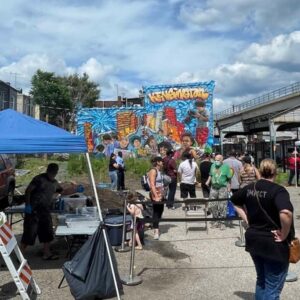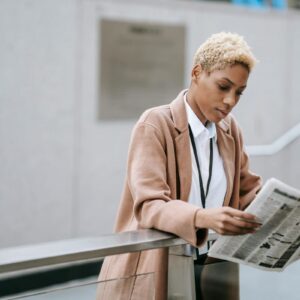
How does your personal history with money shape how you deploy it professionally? For me, the power gap that I felt during my first on-the-ground site visit as a grantmaker was palpable. There were smiles on every face, but tension in all the shoulders.
The moment I stepped out of the car, and walked down the block, power and authority seemed to flow toward me and away from them. I immediately thought about the power dynamics described in Edgar Villanueva’s book Decolonizing Wealth, and the imbalance that people in power often cling to.
Capital carries memory.
If our relationships with money are complex and connected to our emotional state, then fiduciary duty for impact must measure more than basis points.
Whether forged by systemic scarcity, generational privilege, or positional power, people’s history with money determines how risk is priced, who is empowered, who is resourced, and who waits. Yet due diligence and fiduciary checklists rarely, if ever, ask about any of that.
Mental Models and Money
“Working with money is emotional work. We all have a complex relationship with money,” Deb Nelson, executive director of the Just Economy Institute, told NPQ.
Nelson leads a network of 200-plus fellows and allied financial activists, who seek to “shift the flow of capital and power to solve social and environmental problems.”
If our relationships with money are complex and connected to our emotional state, then fiduciary duty for impact must measure more than basis points. Recalibrating how people in power assess risk and share control takes more than new term sheets; it demands emotional intelligence, cultural context, and care integrated into governance norms.
Mission alignment, site visits, and due diligence tools are necessary and important to grantmaking. But those mechanisms don’t quite get to the heart of what it takes to have a positive impact. One of the most underacknowledged assets in this field is emotional resilience, not as a private virtue, but as sectorwide infrastructure.
It is the governance capacity that supports decision-makers in aligning money with values, whether they come from lifelong scarcity or generational stability. So, what are some of these mental models that govern the deployment of capital, and how does that relationship show up in philanthropy and impact investment?
Mental Models and Inequality
One path concerns mispricing risk. Evaluating risk solely based on the capacity of the borrower to handle debt ignores or minimizes the risk of not investing. In fact, mental models of risk assessment often deny lived experiences within systems of extraction (foreclosures, job loss, health concerns).
Nelson says people who hold power over capital are often socialized to believe that their relationship with money is a zero-sum game. The Sum of Us, by Heather McGhee, does a good job of addressing this.
“It’s all based on power over crushing our opponents, you know, making sure that me and my people have more than you and your people,” Nelson added.
Another challenge is a common scarcity mindset. Leadership consulting firm Soil and Shadow’s CEO Nikki Silvestri explained to NPQ that the “experience of scarcity is actually dependent on your formative (childhood) years and whether you had enough love…whether your parents were too stressed out to give you themselves—[such as] their time, care, and support.”
Silvestri’s strategy lab designs regenerative leadership models, such as sustainable leadership and burnout prevention.
When funders and impact investors judge lean teams and tight budgets as virtuous, they often embody a fear of scarcity, while ignoring basic human needs like fair salaries, full benefits, adequate vacation, or sufficient staffing levels.
The Market-Rate Hurdle
An additional hurdle that interferes with effective philanthropy and impact investment is the common use of a market-rate mandate that treats the historical 7 to 10 percent return of the Standard & Poor’s 500 as the universal benchmark for impact deals.
This is based on the long-stated—but inaccurate—claim that impact investors and foundations “do not have to choose between doing good—i.e. generate social or environmental return—or doing well—that is: make a financial return,” as one firm put it.
Replacing “market-rate” with “mission-fit yield” centers the purpose first, then asks what market-rate yield is compatible with mission.
Impact initiatives that set market-rate targets must generate an exorbitant surplus to achieve them, often at the expense of employee salaries and benefits or passing costs onto frontline communities that are already underresourced.
“We’ve built an economy that prioritizes financial capital to the detriment of, and at the expense of, and instead of, in a lot of cases, human and ecological capital,” said Silvestri. “It doesn’t have to be that way.”
Strategies to Realign
So, how can impact investors and funders shift mental models from reinforcing inequality to dismantling it?
It starts with cultivating a sense of abundance—not unfettered optimism but disciplined practice of decision-making that challenges dominant mental models and resets them. This requires establishing new practices at the level of return expectations, supporting care, and restructuring governance. Each of these is detailed below:
- Redefine return on investment (ROI). People who are rested and paid well can deliver deeper, longer-lasting impact. Redefining the return on investment to include avoided foreclosures, carbon dioxide not emitted, jobs preserved, and cultural heritage maintained offers a more accurate and more holistic sense of what impact investment is designed to achieve. Simply put, for the impact investor, ROI really should mean “return on impact.” If impact is a foundation’s goal, then the “risk-of-not-investing” assessment needs to be added to grant application reviews. More broadly, funders and investors interested in a “return on impact” need to employ a multi-capital dashboard (human, ecological, and financial) to track their progress.
- Resource healing justice and somatic care. As Silvestri pointed out, “Feeling is risky. Feeling is tender.” Unacknowledged tension can result in harsh risk assessments or trust gaps. This in turn can result in funder or impact investor rigidity that impedes lending or power sharing. Somatic embodiment, which involves paying attention to bodily sensations and movements, can be a powerful tool to undo these obstacles and significantly enhance decision-making.
Some foundations have started to catch on to the value of this approach. For example, the Loveland Foundation has developed its Therapy Fund, which already has underwritten trauma-informed therapy for thousands of Black women. It is also important to incorporate such practices in the investment process itself, like beginning investment meetings with grounding tools like a 90-second body-scan check-in, a collective sigh and stretch, or mindfulness breaths to surface tension at the outset. In terms of evaluation, report qualitative wellbeing gains alongside financial KPIs each quarter.
- Embed relational governance in boards . Relational governance in boards centers decision-making on mutual accountability rather than positional authority, so frontline voices shape risk and return alongside fiduciaries. That means moving decision rights closer to the communities most affected by capital flows, transforming beneficiaries into co-stewards, and shifting the board’s default question from “Is this safe for us?” to “Is this just for all of us?”
How is this shift in governance accomplished? It begins by funders inviting frontline practitioners who are representative of the community to serve as full fund voting members, not advisory guests. For this to work, it is often important to invest in capacity building.
Another key step is to replace scarcity language with opportunity language in organization documents, including bylaws. Swapping out “allocation” for “contribution” and “disbursement” for “circulation” frames money as something that moves in multiple directions, and that multiple groups value. Replacing “market-rate” with “mission-fit yield” centers the purpose first, then asks what market-rate yield is compatible with mission.
Spreadsheets alone cannot hold the complexity or volatility of the social problems they finance.
Reenvisioning Capital Stewardship
Capital carries the memory we give it. So, to change relations of power, it is vital that funders and impact investors be intentional about it. Many people already are. But more support is needed.
Capital stewards are hungry for somatic literacy. Nelson of the Just Economy Institute notes that her group receives far more applications for the fellowship program than her team can accept. This signals that decision-makers understand that spreadsheets alone cannot hold the complexity or volatility of the social problems they finance.
Relational governance is scaling. Networks such as Seed Commons, Boston Ujima Project, and Apis & Heritage Capital Partners are proving that community- and worker-owners can exercise real voting power over large pools of capital. Seed Commons has already deployed more than $100 million across its network of over 30 community-based partners. Boston Ujima members cast binding votes on every investment the fund makes. And Apis & Heritage’s $58 million Legacy Fund is successfully converting businesses into majority-ESOPs (employee stock ownership plans) where frontline workers are gaining board-level influence.
When capital stewards invest in understanding their money stories and cultivating abundance, somatic care, and relational governance, allocation can better shift from risk avoidance to strategies that are just, sustainable, and equitable. The healthiest portfolios start in the body, not the spreadsheet.














